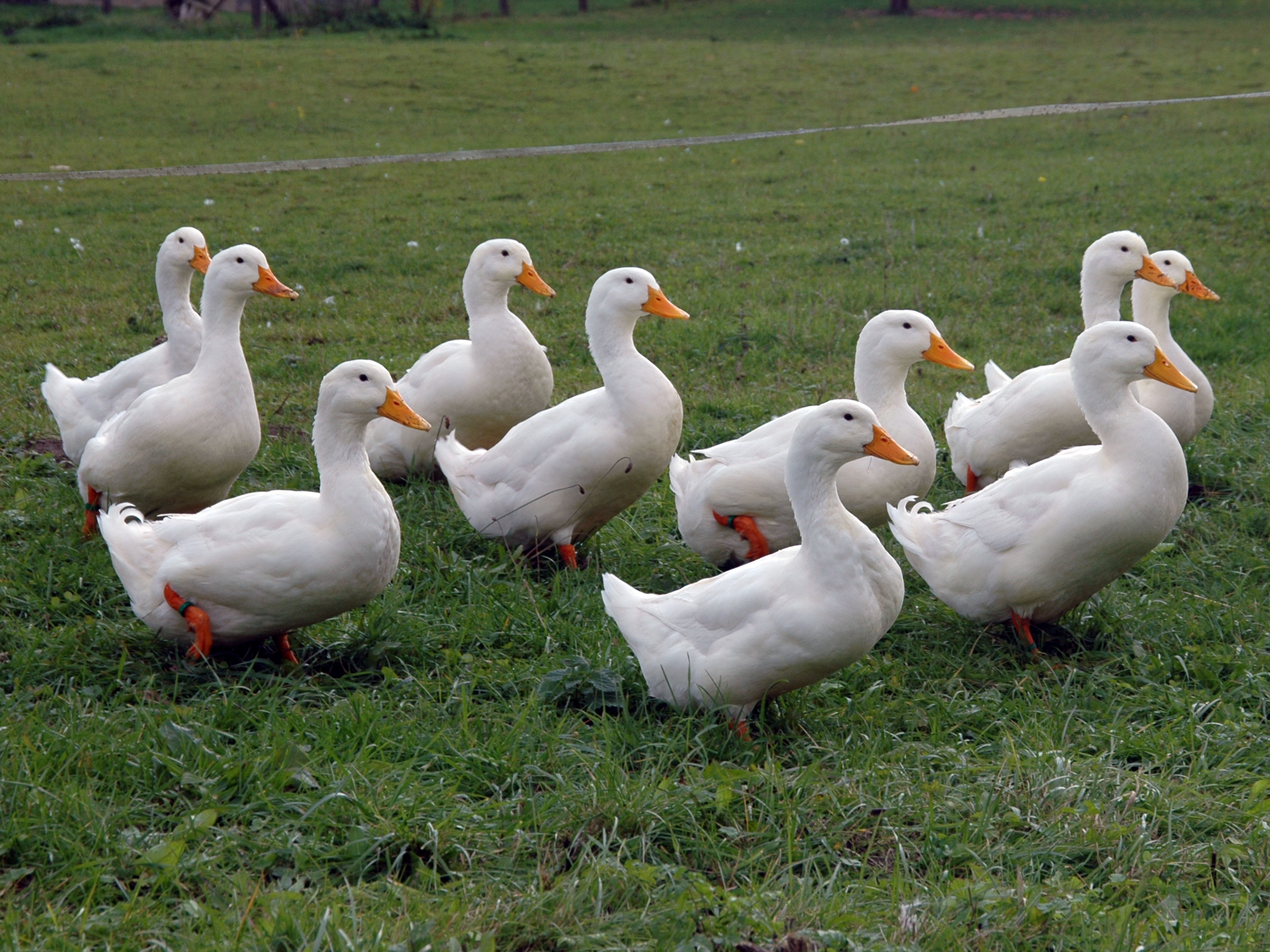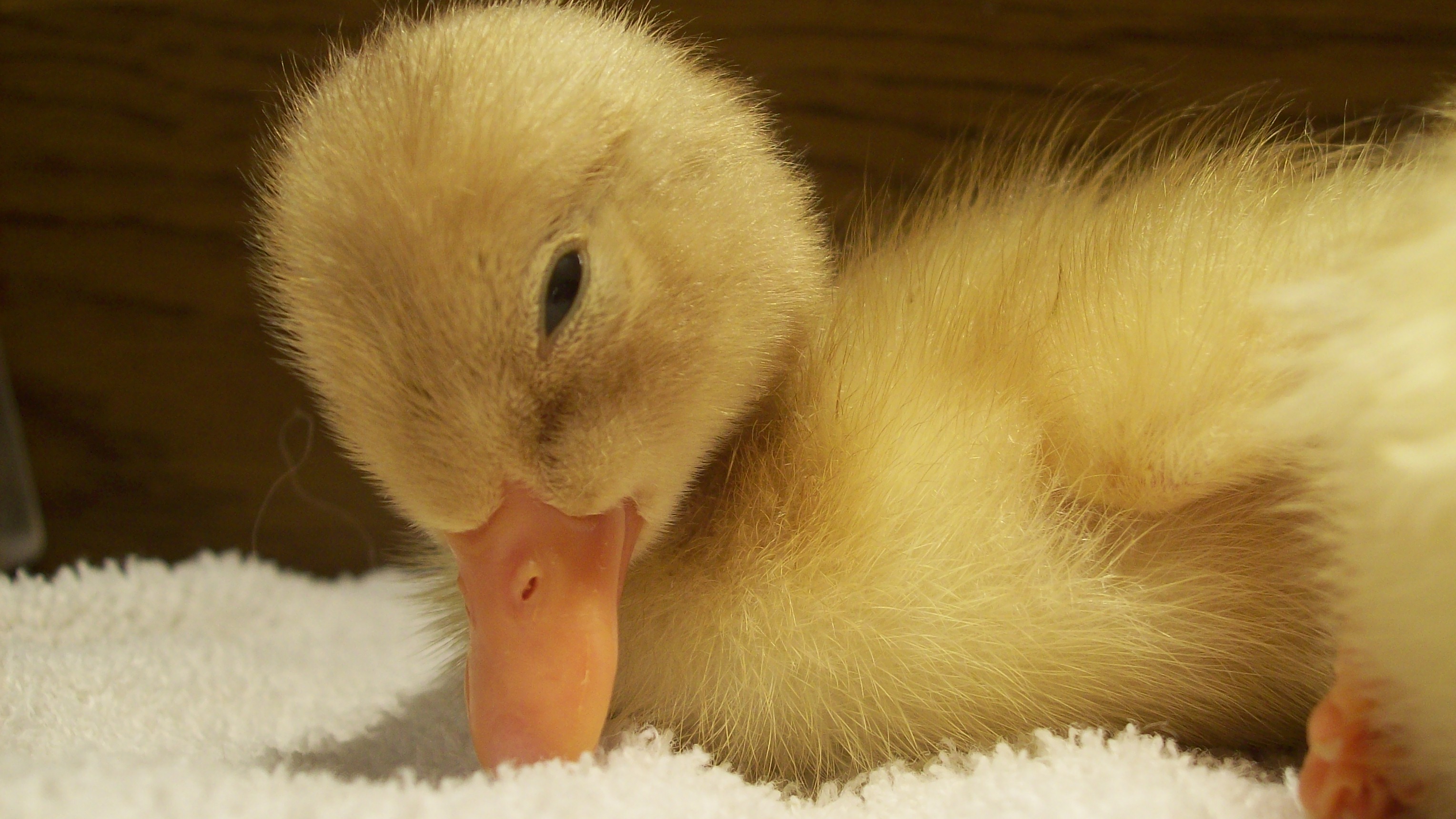American Pekin duck on:
[Wikipedia]
[Google]
[Amazon]
 The Pekin or White Pekin is an American
The Pekin or White Pekin is an American
 The American Pekin is large and solidly built. The body is rectangular as seen from the side and is held at about 40º to the horizontal; the tail projects above the line of the back. The breast is smooth and broad and does not show a pronounced
The American Pekin is large and solidly built. The body is rectangular as seen from the side and is held at about 40º to the horizontal; the tail projects above the line of the back. The breast is smooth and broad and does not show a pronounced
 The Pekin or White Pekin is an American
The Pekin or White Pekin is an American breed
A breed is a specific group of domestic animals having homogeneous appearance (phenotype), homogeneous behavior, and/or other characteristics that distinguish it from other organisms of the same species. In literature, there exist several slig ...
of domestic duck, raised primarily for meat
Meat is animal flesh that is eaten as food. Humans have hunted, farmed, and scavenged animals for meat since prehistoric times. The establishment of settlements in the Neolithic Revolution allowed the domestication of animals such as chic ...
. It derives from birds brought to the United States from China in the nineteenth century, and is now bred in many parts of the world. It is often known as the American Pekin to distinguish it from the German Pekin
The German Pekin, german: , is a European breed of domestic duck. It is commonly called simply Pekin or White Pekin. It is a different breed from the American Pekin, which is also commonly known by the same names. It was bred in Europe from ...
, a distinct and separate breed which derives from the same Chinese stock but has different breeding
Breeding is sexual reproduction that produces offspring, usually animals or plants. It can only occur between a male and a female animal or plant.
Breeding may refer to:
* Animal husbandry, through selected specimens such as dogs, horses, and r ...
. Many of these ducks were reared on Long Island
Long Island is a densely populated island in the southeastern region of the U.S. state of New York, part of the New York metropolitan area. With over 8 million people, Long Island is the most populous island in the United States and the 18 ...
, New York
New York most commonly refers to:
* New York City, the most populous city in the United States, located in the state of New York
* New York (state), a state in the northeastern United States
New York may also refer to:
Film and television
* '' ...
, in the late nineteenth and early twentieth centuries, from which the breed derived its name Long Island Duck.
History
Themallard
The mallard () or wild duck (''Anas platyrhynchos'') is a dabbling duck that breeds throughout the temperate and subtropical Americas, Eurasia, and North Africa, and has been introduced to New Zealand, Australia, Peru, Brazil, Uruguay, Argen ...
was domesticated
Domestication is a sustained multi-generational relationship in which humans assume a significant degree of control over the reproduction and care of another group of organisms to secure a more predictable supply of resources from that group. A ...
in China some 3000 years ago, and possibly much earlier. Force-feeding of ducks is documented from the tenth century, under the Five Dynasties
The Five Dynasties and Ten Kingdoms period (), from 907 to 979, was an era of political upheaval and division in 10th-century Imperial China. Five dynastic states quickly succeeded one another in the Central Plain, and more than a dozen conc ...
. The Chinese were sophisticated breeders of ducks; among several breeds they created was one named ''shi-chin-ya-tze'', which roughly translates to "ten-pound duck", from which the American Pekin derives.
In 1872, James E. Palmer of Stonington, Connecticut
The town of Stonington is located in New London County, Connecticut in the state's southeastern corner. It includes the borough of Stonington, the villages of Pawcatuck, Lords Point, and Wequetequock, and the eastern halves of the villages of ...
, loaded fifteen white ducks of this type for shipment to a businessman named McGrath in the United States. The birds were loaded at Shanghai
Shanghai (; , , Standard Chinese, Standard Mandarin pronunciation: ) is one of the four Direct-administered municipalities of China, direct-administered municipalities of the China, People's Republic of China (PRC). The city is located on the ...
but had been hatched in Peking
}
Beijing ( ; ; ), alternatively romanized as Peking ( ), is the capital of the People's Republic of China. It is the center of power and development of the country. Beijing is the world's most populous national capital city, with over 21 ...
(now called Beijing). Nine of them – six hens and three drakes – survived the voyage, which took 124 days and reached New York City
New York, often called New York City or NYC, is the List of United States cities by population, most populous city in the United States. With a 2020 population of 8,804,190 distributed over , New York City is also the L ...
on 13 March 1873. Five of the surviving birds were dispatched to McGrath but were eaten before they reached him. Palmer's four birds became the foundation stock of the American Pekin; by July 1873, his three hens had laid more than three hundred eggs.
In 1874, the Pekin was included in the first edition of the ''Standard of Perfection
The ''American Standard of Perfection'' is the official breed standard for the poultry fancy in North America. First published in 1874 by the American Poultry Association, the ''Standard of Perfection'' (commonly referred to as "the ''Standard ...
'' published by the new American Poultry Association
The American Poultry Association (APA) is the oldest poultry organization in the North America. It was founded in 1873, and incorporated in Indiana in 1932.
The first American poultry show was held in 1849, and the APA was later formed in resp ...
. It was soon in widespread production for slaughter. Until that time, a popular breed raised for meat had been the Cayuga Cayuga often refers to:
* Cayuga people, a native tribe to North America, part of the Iroquois Confederacy
* Cayuga language, the language of the Cayuga
Cayuga may also refer to:
Places Canada
* Cayuga, Ontario
United States
* Cayuga, Illinoi ...
, which had the disadvantage of dark feathering, so that any fluff remaining on the carcass was easily seen; the white-feathered Pekin was preferable.
Other birds of the same type were imported to the United Kingdom in 1872 and from there soon reached Germany, where they gave rise to the German Pekin
The German Pekin, german: , is a European breed of domestic duck. It is commonly called simply Pekin or White Pekin. It is a different breed from the American Pekin, which is also commonly known by the same names. It was bred in Europe from ...
, a distinct and separate breed. In Germany, the Chinese ducks were cross-bred
A crossbreed is an organism with purebred parents of two different breeds, varieties, or populations. ''Crossbreeding'', sometimes called "designer crossbreeding", is the process of breeding such an organism, While crossbreeding is used to mai ...
with upright white ducks brought from Japan by Dutch ships, resulting in birds with a steep body angle; those taken to the United States were crossed with birds of the British Aylesbury
Aylesbury ( ) is the county town of Buckinghamshire, South East England. It is home to the Roald Dahl Children's Gallery, David Tugwell`s house on Watermead and the Waterside Theatre. It is in central Buckinghamshire, midway between High Wy ...
breed, which led to birds with a more horizontal stance. The Pekin in the United Kingdom derives from birds imported from Germany from about 1970.
Characteristics
 The American Pekin is large and solidly built. The body is rectangular as seen from the side and is held at about 40º to the horizontal; the tail projects above the line of the back. The breast is smooth and broad and does not show a pronounced
The American Pekin is large and solidly built. The body is rectangular as seen from the side and is held at about 40º to the horizontal; the tail projects above the line of the back. The breast is smooth and broad and does not show a pronounced keel
The keel is the bottom-most longitudinal structural element on a vessel. On some sailboats, it may have a hydrodynamic and counterbalancing purpose, as well. As the laying down of the keel is the initial step in the construction of a ship, in Br ...
. The head is large and rounded, and the neck is thick. The plumage is creamy white, the legs and feet are a yellowish orange. The beak is yellow, fairly short, and almost straight.
Use
The American Pekin is raised almost exclusively formeat
Meat is animal flesh that is eaten as food. Humans have hunted, farmed, and scavenged animals for meat since prehistoric times. The establishment of settlements in the Neolithic Revolution allowed the domestication of animals such as chic ...
. In the United States, more than half of all ducks raised for slaughter are of this breed. Numbers in the United States alone are in the tens of millions. The birds are large-framed, hardy and fast-growing – they may reach a body-weight of more than in seven weeks. They have a high feed conversion ratio
In animal husbandry, feed conversion ratio (FCR) or feed conversion rate is a ratio or rate measuring of the efficiency with which the bodies of livestock convert animal feed into the desired output. For dairy cows, for example, the output is milk ...
, are calm-tempered and fertile, and their eggs have a high rate of hatchability. The white feathers make the carcass easy to clean after being plucked.
A number of commercial strains have been developed, including types kept solely as layers. From the time the birds reached the United States, selective breeding
Selective breeding (also called artificial selection) is the process by which humans use animal breeding and plant breeding to selectively develop particular phenotypic traits (characteristics) by choosing which typically animal or plant ...
of meat birds was mainly directed towards size, strength and rate of growth. More recently, attempts have been made to reduce the proportion of fat in the carcass, even if growth rate and feed conversion ratio are also reduced.
Pekin ducks may lay over 150 white eggs per year. They are not good sitters, and eggs may need to be artificially incubated.
The American Pekin is sometimes kept for fancy
Fancy may refer to:
Places
* Fancy, Saint Vincent and the Grenadines, a settlement
* Fancy River, Saint Vincent and the Grenadines
Music Albums
* ''Fancy'' (Bobbie Gentry album), 1970
* ''Fancy'' (Idiot Flesh album), 1997
* ''Fancy'' (video ...
and showing. Show birds are often larger than commercial production stock.
Notes
References
{{Authority control, state=collapsed Duck breeds Duck breeds originating in the United States